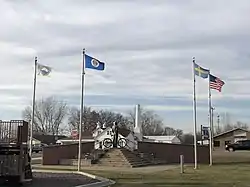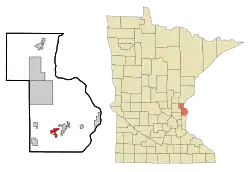Chisago City, Minnesota
Chisago City (/ʃɪˈsɑːɡoʊ/ shi-SAH-goh)[5] is a city in Chisago County, Minnesota, United States, approximately 35 miles northeast of downtown Minneapolis–Saint Paul. The population was 4,967 at the 2010 census.[6]
Chisago City | |
|---|---|
 Statue of Vilhelm Moberg in downtown Chisago City | |
| Motto: "Gateway to the Lakes"[1] | |
 Location of Chisago City within Chisago County, Minnesota | |
| Coordinates: 45°21′54″N 92°53′12″W | |
| Country | United States |
| State | Minnesota |
| County | Chisago |
| Area | |
| • Total | 14.78 sq mi (38.28 km2) |
| • Land | 12.56 sq mi (32.53 km2) |
| • Water | 2.22 sq mi (5.75 km2) |
| Elevation | 919 ft (280 m) |
| Population (2020) | |
| • Total | 5,558 |
| • Density | 442.52/sq mi (170.85/km2) |
| Time zone | UTC-6 (Central (CST)) |
| • Summer (DST) | UTC-5 (CDT) |
| ZIP code | 55013 |
| Area code | 651 |
| FIPS code | 27-11350[4] |
| GNIS feature ID | 663797[3] |
| Website | www.ci.chisago.mn.us |
The city is between the twin lakes of Chisago Lake and Green Lake, and is part of the Chisago lakes region.
Geography
According to the United States Census Bureau, the city has a total area of 14.99 square miles (38.82 km2), of which 12.53 square miles (32.45 km2) is land and 2.46 square miles (6.37 km2) is water.[7]
Infrastructure
Transportation
U.S. Highway 8 serves as a main route for the community.
History
Chisago City was founded in May 1857 by Anders Swenson, a Swedish immigrant from Småland. He was born in 1817 and came to America in 1850.[8] The city took its name from Chisago Lake.[9]
During 1852 only a few settlers arrived. John Smith came from Örtofta in the spring of that year. Ahead of him, he declared, were only five settlers at Chisago Lake.
During 1853-54 a substantial number of Swedish immigrants arrived, most of them from Kronoberg County. Most of the land around the lake was taken up and settled During the settlement's first three or four years. Later-arriving immigrants had to go farther into the country to secure homesteads.
Chisago City was originally settled one mile south, but when the railroad bypassed the town in 1880, the city moved closer to the railroad, as often happened during that time.[10]
Demographics
| Census | Pop. | Note | %± |
|---|---|---|---|
| 1880 | 92 | — | |
| 1910 | 276 | — | |
| 1920 | 422 | 52.9% | |
| 1930 | 416 | −1.4% | |
| 1940 | 510 | 22.6% | |
| 1950 | 703 | 37.8% | |
| 1960 | 772 | 9.8% | |
| 1970 | 1,068 | 38.3% | |
| 1980 | 1,634 | 53.0% | |
| 1990 | 2,009 | 22.9% | |
| 2000 | 2,622 | 30.5% | |
| 2010 | 4,967 | 89.4% | |
| 2020 | 5,558 | 11.9% | |
| U.S. Decennial Census | |||
2010 census
As of the census[11] of 2010, there were 4,967 people, 2,051 households, and 1,306 families living in the city. The population density was 396.4 inhabitants per square mile (153.1/km2). There were 2,209 housing units at an average density of 176.3 per square mile (68.1/km2). The racial makeup of the city was 96.7% White, 0.6% African American, 0.5% Native American, 0.6% Asian, 0.1% Pacific Islander, 0.3% from other races, and 1.1% from two or more races. Hispanic or Latino of any race were 1.7% of the population.
There were 2,051 households, of which 29.8% had children under the age of 18 living with them, 51.9% were married couples living together, 7.5% had a female householder with no husband present, 4.3% had a male householder with no wife present, and 36.3% were non-families. 31.5% of all households were made up of individuals, and 18.9% had someone living alone who was 65 years of age or older. The average household size was 2.35 and the average family size was 2.93.
The median age in the city was 43.3 years. 22.7% of residents were under the age of 18; 6.4% were between the ages of 18 and 24; 22.9% were from 25 to 44; 27.9% were from 45 to 64; and 20.2% were 65 years of age or older. The gender makeup of the city was 48.4% male and 51.6% female.
2000 census
As of the census[4] of 2000, there were 2,622 people, 1,038 households, and 685 families living in the city. The population density was 1,329.0 inhabitants per square mile (513.1/km2). There were 1,107 housing units at an average density of 561.1 per square mile (216.6/km2). The racial makeup of the city was 97.10% White, 0.53% African American, 0.19% Native American, 0.46% Asian, 0.08% Pacific Islander, 0.57% from other races, and 1.07% from two or more races. Hispanic or Latino of any race were 1.60% of the population.
There were 1,038 households, out of which 32.9% had children under the age of 18 living with them, 51.4% were married couples living together, 10.1% had a female householder with no husband present, and 34.0% were non-families. 29.2% of all households were made up of individuals, and 17.1% had someone living alone who was 65 years of age or older. The average household size was 2.42 and the average family size was 2.96.
In the city, the population was spread out, with 25.1% under the age of 18, 8.0% from 18 to 24, 27.8% from 25 to 44, 18.1% from 45 to 64, and 21.0% who were 65 years of age or older. The median age was 38 years. For every 100 females, there were 87.3 males. For every 100 females age 18 and over, there were 81.3 males.
The median income for a household in the city was $38,352, and the median income for a family was $51,964. Males had a median income of $38,988 versus $27,163 for females. The per capita income for the city was $22,321. About 3.8% of families and 6.0% of the population were below the poverty line, including 4.1% of those under age 18 and 8.0% of those age 65 or over.
Sister cities
See also
References
- "Chisago City Minnesota". Chisago City Minnesota. Retrieved October 4, 2012.
- "2020 U.S. Gazetteer Files". United States Census Bureau. Retrieved July 24, 2022.
- U.S. Geological Survey Geographic Names Information System: Chisago City, Minnesota
- "U.S. Census website". United States Census Bureau. Retrieved January 31, 2008.
- "Minnesota Pronunciation Guide". Associated Press. Archived from the original on July 22, 2011. Retrieved July 4, 2011.
- "2010 Census Redistricting Data (Public Law 94-171) Summary File". American FactFinder. U.S. Census Bureau, 2010 Census. Retrieved April 23, 2011.
- "US Gazetteer files 2010". United States Census Bureau. Archived from the original on January 25, 2012. Retrieved November 13, 2012.
- Chisago City Heritage of Chisago City MN, Chisago County
- Upham, Warren (1920). Minnesota Geographic Names: Their Origin and Historic Significance. Minnesota Historical Society. p. 108.
- The Beginning Archived 2007-06-17 at the Wayback Machine
- "U.S. Census website". United States Census Bureau. Retrieved November 13, 2012.
External links
- Chisago City Official Website
- Chisago City Heritage
- Chisago City, Minnesota at the Minnesota Historical Society.
